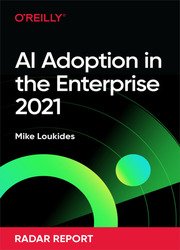AI Adoption in the Enterprise 2021
- Добавил: literator
- Дата: 26-04-2021, 19:31
- Комментариев: 0
 Название: AI Adoption in the Enterprise 2021
Название: AI Adoption in the Enterprise 2021Автор: Mike Loukides
Издательство: O'Reilly Media, Inc.
Год: 2021
Язык: английский
Формат: pdf, epub
Размер: 10.1 MB
There's no question: more people are using AI than ever before, and companies across industries are striving to get AI projects up and running. But how many have actually put revenue-bearing products into production? And how does your own organization measure up?
In this new report, Mike Loukides, O'Reilly's vice president of content strategy, shares the results of a recent survey on how companies are adopting AI. You'll learn how (and where) AI use has grown over the past year, the significant barriers that remain, and the techniques and tools developers are--or should be--using for their applications.
First, 82% of the respondents are using supervised learning, and 67% are using deep learning. Deep learning is a set of algorithms that are common to almost all AI approaches, so this overlap isn’t surprising. (Participants could provide multiple answers.) 58% claimed to be using unsupervised learning. After unsupervised learning, there was a significant drop-off. Human-in-the-loop, knowledge graphs, reinforcement learning, simulation, and planning and reasoning all saw usage below 40%. Surprisingly, natural language processing wasn’t in the picture at all. (A very small number of respondents wrote in “natural language processing” as a response, but they were only a small percentage of the total.) This is significant and definitely worth watching over the next few months. In the last few years, there have been many breakthroughs in NLP and NLU (natural language understanding): everyone in the industry has read about GPT-3, and many vendors are betting heavily on using AI to automate customer service call centers and similar applications. This survey suggests that those applications still haven’t moved into practice.
Respondents with mature practices clearly had their favorite tools: scikit-learn, TensorFlow, PyTorch, and Keras each scored over 45%, with scikit-learn and TensorFlow the leaders (both with 65%). A second group of tools, including Amazon’s SageMaker (25%), Microsoft’s Azure ML Studio (21%), and Google’s Cloud ML Engine (18%), clustered around 20%, along with Spark NLP and spaCy.
Скачать AI Adoption in the Enterprise 2021
Внимание
Уважаемый посетитель, Вы зашли на сайт как незарегистрированный пользователь.
Мы рекомендуем Вам зарегистрироваться либо войти на сайт под своим именем.
Уважаемый посетитель, Вы зашли на сайт как незарегистрированный пользователь.
Мы рекомендуем Вам зарегистрироваться либо войти на сайт под своим именем.
Информация
Посетители, находящиеся в группе Гости, не могут оставлять комментарии к данной публикации.
Посетители, находящиеся в группе Гости, не могут оставлять комментарии к данной публикации.
